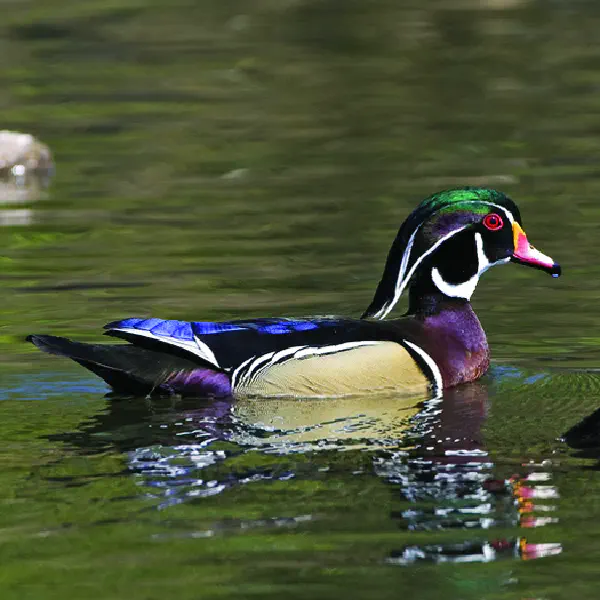Aix sponsa
Table of Contents

Scientific Classification
| Kingdom: Animalia |
| Phylum: Chordata |
| Class: Aves |
| Order: Anseriformes |
| Family: Anatidae |
| Genus: Aix |
| Species: Aix sponsa |
Conservation Status
Identifying Features
Wood ducks are sexually dimorphic, with males being larger and appearing more colorful. On average wood ducks are about 19 inches in length and have a 30 inch wingspan. Both have crests on their heads, rectangular tails, white bellies, and white stripes running along their wings. Males have dark purple backs and chests with bronze wings. Their irridescent heads have shades of green, blue, and purple with red eyes as well as white throats with two white stripes that run from the base of their bill up to their eyes. Females are brownish gray with white rings around their eyes and white throats.
Habitat & Range
Wood ducks can be found in wetlands along the eastern coast of North America from Nova Scotia down to Florida, and as far west as the middle of the United States. They can also be found on the western coast from British Columbia down to the top border of Mexico. Northern populations migrate to the southern coasts of California and into the western coasts of Northern Mexico.
Wood ducks always nest within 1 mile of freshwater, including rivers, streams, lakes, vegetated marshes, and ponds.
Behavior
Wood ducks are diurnal and will sleep in the water, with the exception of females with ducklings. They are social and will often congregate in the evening and migrate in pairs or small flocks. Male wood ducks are serially monogamous, staying with the same female for an entire mating season.
Wood ducks are omnivorous, feeding on many food items found in aquatic ecosystems, including aquatic plants and seeds, fruits, nuts, and aquatic insects and invertebrates.
Life Cycle
Wood ducks court in the fall and spring, with the breeding season from February to March in the South and March to April in the North. Wood ducks are cavity nesters, and females lay 6-15 eggs per season. Eggs hatch after a 1 month incubation period and immediately leave the nest. They are fully mature and independant after a year.
Featured image by Kevin Cole

